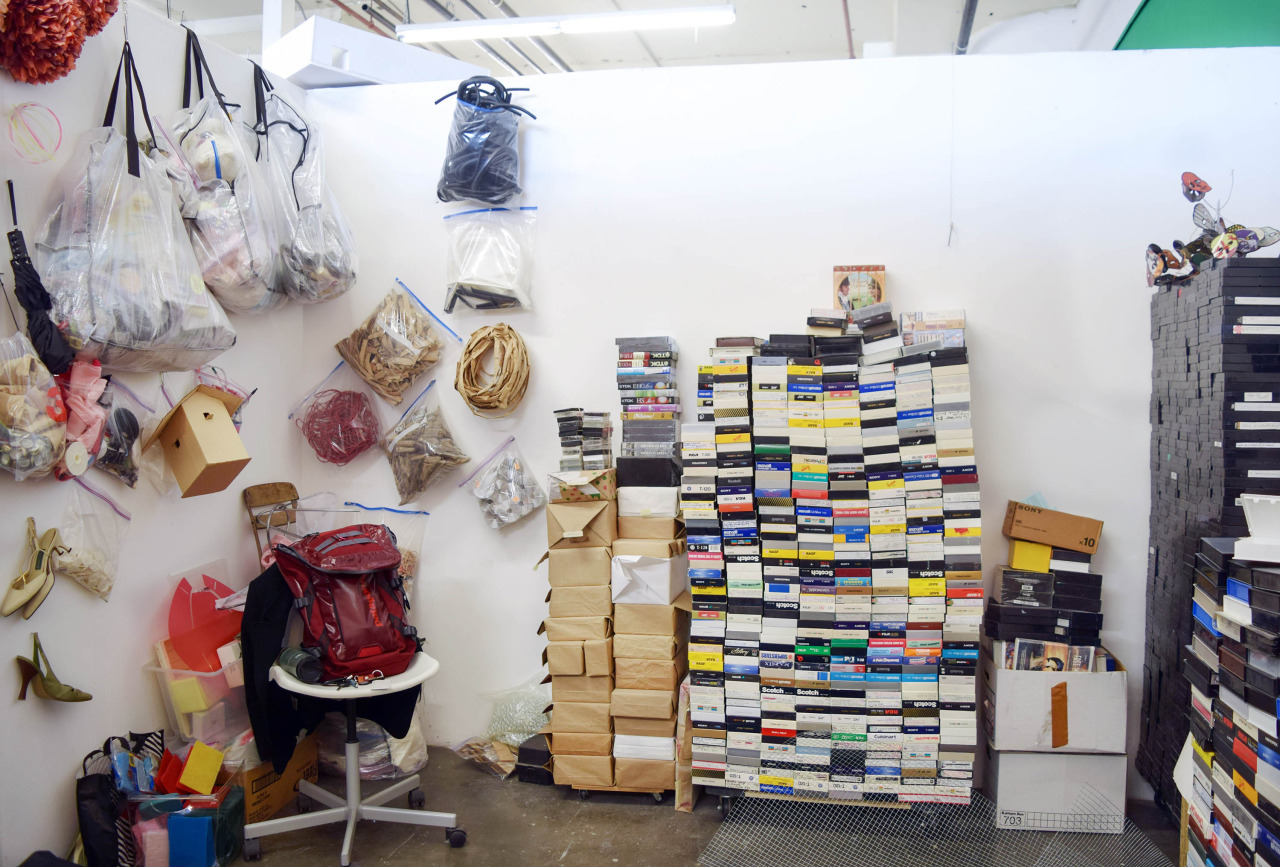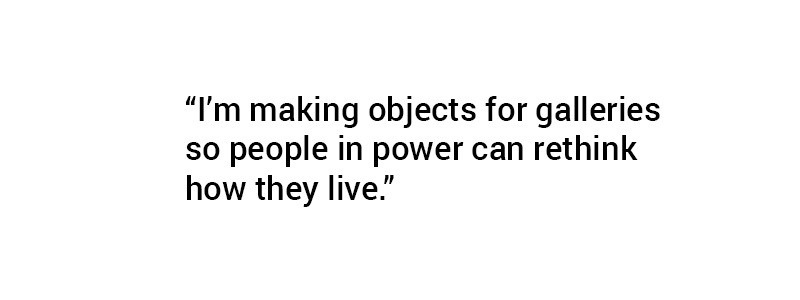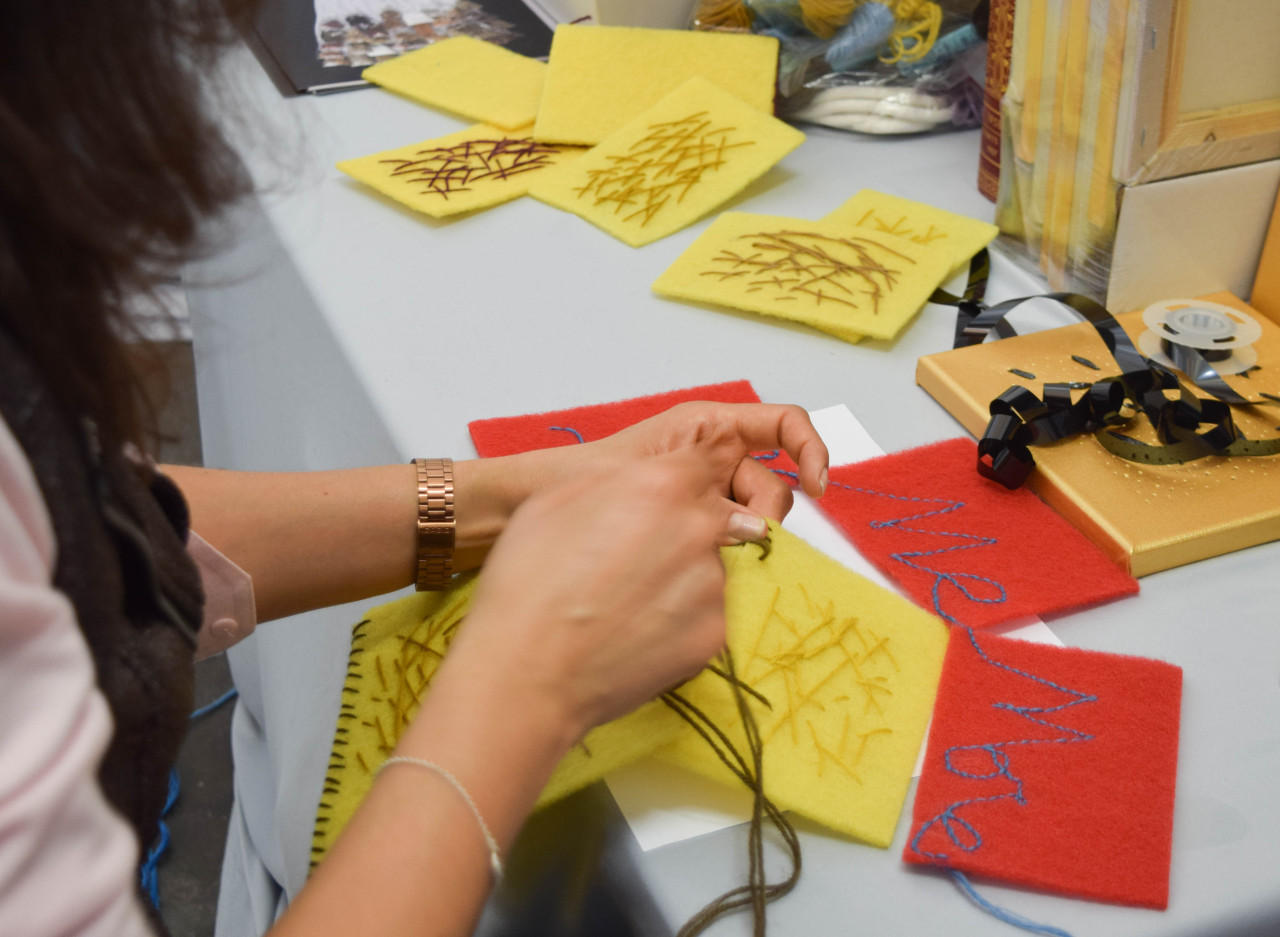Driftwood, cord, and piles of VHS tapes fill Cristina Velázquez’s (Dual MA/MFA, History and Theory of Contemporary Art / Studio Art, 2017) studio—organized chaos waiting to be activated. An artist working with discarded and found materials, Velázquez employs a materially-driven process to critique contemporary issues of environmentalism, feminism, and parallels between the two. As an artist and theorist, Velázquez empowers women and her heritage.
SFAI: Describe your art practice and the type of work you make.
I make art out of what I call “recyclables and repurposables.” After graduating from San Jose State University with a BFA in painting, I never went back to the brushes. I paint through installation—my brushstrokes and marks are made with media that I collect, repurpose, and transform. I use what is already here and use it to say something meaningful, most specifically about the implications and expectations of women.
I’ve always made work for the greater community so we can make change together. SFAI is a place for people who make things happen, which is what drew me here.

What was one of your first installation series?
My first body of work was 10 repurposed dresses that hold objects to represent facets of femininity, domesticity, and socially imposed roles. It started with the dress Women Must Bear Children [above middle image]. It references female reproductive rights and the cultural stereotype that Mexican women should have a big family. This work challenges other women in my community to think about this decision and who gets to make it. Other dresses in the series include Women Must Cook, Women Must Be Beautiful, and Women Must be Good Lovers, to name a few.
People always want to see me perform in them, but they are exhibited flat against the wall. In Mexico we have a saying, “I’m being ignored the way you ignore a painting on the wall.” Women are still viewed as objects and subjects of lesser value. The power and mission behind my art-making is to promote women’s many facets—I seek to elevate the status of Mexican women.

What ideas and concepts do you explore in your work?
My artwork explores femininity, psychology, ecology, and culture. For example, before I started grad school, I noticed a lot of VHS tapes in the trash—old technology cast off. I thought of how this lifecycle mimics that of women: treated and discarded. In my culture, older women wear a black shawl, rebozo, so I decided to knit never-ending shawls of VHS film. There’s still tension between fine art and craft, but there’s something about handiwork that connects women.

Was there a collaborative/participatory aspect to this project?
I wanted to open up this project to engage the community. While an Artist-in-Residence at the Palo Alto Art Center, I created knitting circles, inviting others to help me grow the shawls. People came to help knit, pull apart the tape, or discuss current conditions in our community related to consumption, ecology, and recycling.
Your work involves attention to detail and repetition. How do these techniques influence you conceptually?
I’ve always been an artist who wants to create things with my own hands. In the studio I create objects in the same way women have been doing for years in the home. In that repetition I find a meditational way of thinking and working.
How has your experience as an Artist in Residence at Recology influenced your perspective on our culture of accumulation?
Recology has been an amazing experience. The first couple days inside the Public Disposal Area, I was in disbelief at the amount of trash—and the amount of objects that are not trash. Taking in the sounds, sights, and smells, I realized that even in San Francisco, a zero waste city, we aren’t doing enough.
After being in the Public Disposal Area at Recology, a store has the same impact on me. I look at all these things and ask myself, “Why do we make more?” As long as there’s trash, there’s going to be a trash problem.


How do you use a rhetoric of formalism to bring in a generalized audience into your feminine critique?
The story I tell through art is always about women, but it’s not always literal. I’m making objects for galleries so that people in power can rethink how they live.
In other works I challenge femininity and objectification more directly. For example: one installation repurposes rope into a shell, a phallic shape representing patriarchy I danced freely inside it while blindfolded and listened to headphones. This work explores the duality of feeling both free and oppressed, making the audience feel as uncomfortable as women are on a daily basis. This piece plays with freedoms I have and exercise, while feeling trapped in them.
Does your MA research relate to your inquiries as an artist?
Last year I was writing a lot about ecofeminism and thought that my MA thesis would be about that. My inquiry changed when I went on SFAI’s Chilean Winter Intensive last year. We visited the Museum of Memory and Human Rights, and I was really affected by the repository of displaced objects and films from the Pinochet regime (1973-1990). The experience was pivotal and transformed my thinking, art practice, and MA thesis.
My research now focuses on Mexico’s missing bodies—the women in Juárez, the 43 students missing from Guerrero, and the drug cartel in Michoacán—through the lens of female artist-activists. One case study will be with Mexican conceptual artist Teresa Margolles who fights against the erasure of Mexican bodies using forensic material, such as the tongue of a victim from drug cartel violence. I’m visually analyzing her body of work but also critiquing the political implications around the use of bodily remains, especially in Mexican-Catholic tradition, and the ethics of exhibiting this subject matter internationally, such as at the 2009 Venice Biennale’s Mexican Pavilion.
In my research I’ll go back to Mexico as the “other” and study how artists are asking questions: Who is at fault? When are we going to fix it? Who is going to do it? I’ll investigate how art can say something, do something, and not remain silent.
After all, to advocate for others is what art is about. As an artist I teach through visuals and objects. My artwork has purpose: to inflict a little pain and send you home thinking more about the current conditions of our existence.
See Cristina’s work on view at Recology San Francisco Artist in Residence Exhibition May 20- May 24, 2016.
Learn more about Cristina Velázquez’s work.
Learn more about SFAI’s Dual Degree MA/MFA Program.
Image credits: 1-5) Installation view of Cristina Velázquez studio Photo by Stephanie Smith 6) Cristina Velázquez, Women Must Cook, from the series Everything I Must Be… Courtesy of the artist 7) Cristina Velázquez, Women Must Bear Children, from the series Everything I Must Be… Courtesy of the artist 8) Cristina Velázquez, Women Must be Beautiful, from the series Everything I Must Be… Courtesy of the artist 9) Installation view of Cristina Velázquez studio Photo by Stephanie Smith 10) Installation view of Cristina Velázquez’s space at the 2016 Graduate Exhibition, on view May 12-15, 2016. Photo by EfrenAve. Courtesy of the artist 11) Photo of Cristina Velázquez photo by EfrenAve. Courtesy of the artist 12) Installation view of Cristina Velázquez’s space at the 2016 Graduate Exhibition, on view May 12-15, 2016. Photo by EfrenAve. Courtesy of the artist.






